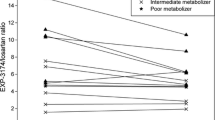Abstract
The effect of hepatic impairment on the pharmacokinetics of escitalopram was determined by means of nonlinear mixed effect modeling, considering both the Child-Pugh classification (and its components) and cytochrome P450 2C19 (CYP2C19) activity. Twenty-four subjects were grouped according to their Child-Pugh score as healthy, with mild hepatic impairment or with moderate hepatic impairment. The subjects were administered a single oral dose of escitalopram 20 mg, and blood was sampled up to 168 hours after dosage. The serum concentration of escitalopram was determined and the pharmacokinetics assessed by nonlinear mixed effect modeling. The CYP2C19 activity was measured from the urinary excretion ratio of S/R-mephenytoin. All subjects tolerated the treatment well, and no serious adverse events were reported. Predicted mean area under the curve from zero to infinity (AUCinf) values were 51% and 69% higher for patients with mild and moderate hepatic impairment (Child-Pugh classification), respectively, compared with healthy subjects. The best-fitting model showed an influence of CYP2C19 activity on clearance and body weight on the volume of distribution for escitalopram. CYP2C19 activity is a better predictor of escitalopram clearance than is Child-Pugh classification.
Similar content being viewed by others
References
U.S. Department of Health and Human Services. Guidance for Industry: Pharmacokinetics in Patients with Impaired Hepatic Function: Study Design, Data Analysis, and Impact on Dosing and Labeling. Available at: http://www.fda.gov/cder/guidance/3625fnl.pdf. Accessed January 10, 2006.
The European Agency for the Evaluation of Medicinal Products. Note for Guidance on the Evaluation of the Pharmacokinetics of Medicinal Products in Patients With Impaired Hepatic Function. Available at: http://www.emea.eu.int. Accessed January 10, 2006.
Rochat B, Kosel M, Boss G, Testa B, Gillet M, Baumann P. Stereoselective biotransformation of the selective serotonin reuptake inhibitor RS-citalopram and its demethylated metabolites by monoamine oxidases in human liver.Biochem Pharmacol. 1998;56:15–23.
Von Moltke LL, Greenblatt DJ, Giancarlo GM, Granda BW, Harmatz JS, Shader RI. Escitalopram (S-citalopram) and its metabolites in vitro: cytochromes mediating biotransformation, inhibitory effects, and comparison to R-citalopram.Drug Metab Dispos. 2001;29: 1102–1109.
Hyttel J, Arnt J, Sánchez C. The pharmacology of citalopram. RevContemp Pharmacother. 1995;6:271–285.
Larrey D, Babany G, Tinel M, et al. Effect of liver disease on dextromethorphan oxidation capacity and phenotype: a study of 107 patients.Br J Clin Pharmacol. 1989;28:297–304.
Morgan DJ, McLean AJ. Clinical pharmacokinetic and pharmacodynamic considerations in patients with liver disease: an update.Clin Pharmacokinet. 1995;29:370–391.
Rost KL, Brockmöller J, Esdorn F, Roots I. Phenocopies of poor metabolizers of omeprazole caused by liver disease and drug treatment.J Hepatol. 1995;23:268–277.
Adedoyin A, Arns PA, Richards WO, Wilkinson GR, Branch RA. Selective effect of liver disease on the activities of specific metabolising enzymes: investigation of cytochromes P450 2C19 and 2D6.Clin Pharmacol Ther. 1998;64:8–17.
Pugh RNH, Murray-Lyon IM, Dawson JL, Pietroni MC, Williams R. Transection of the oesophagus for bleeding oesophageal varices.Br J Surg. 1973;60:646–649.
Child CG, Turcotte JG. Surgery and portal hypertension. In: Child CG, ed.The Liver and Portal Hypertension.Philadelphia, PA: Saunders; 1964:50–64.
American Psychiatric Association.Diagnostic and Statistical Manual of Mental Disorders, 4th ed. Washington, DC: American Psychiatric Association; 2000.
Wedlund PJ, Aslanian WS, McAllister CB, Wilkinson GR, Branch RA. Mephenytoin hydroxylation deficiency in Caucasians: frequency of a new oxidative drug metabolism polymorphism.Clin Pharmacol Ther. 1984;36:773–780.
Küpfer A, Preisig R. Pharmacogenetics of mephenytoin: a new drug hydroxylation polymorphism in man.Eur J Clin Pharmacol. 1984;26:753–759.
Beal SL, Sheiner LB.NONMEM User's guide. San Francisco, CA: University of California; 1979.
Joffe P, Larsen FS, Pedersen V, Ring-Larsen H, Aaes-Jorgensen T, Sidhu J. Single-dose pharmacokinetics of citalopram in patients with moderate renal insufficiency or hepatic cirrhosis compared with healthy subjects.Eur J Clin Pharmacol. 1998;54:237–242.
Author information
Authors and Affiliations
Corresponding author
Rights and permissions
About this article
Cite this article
Areberg, J., Christophersen, J.S., Poulsen, M.N. et al. The pharmacokinetics of escitalopram in patients with hepatic impairment. AAPS J 8, 2 (2006). https://doi.org/10.1208/aapsj080102
Received:
Accepted:
Published:
DOI: https://doi.org/10.1208/aapsj080102




